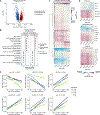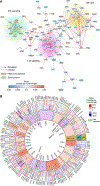Host-microbe multiomic profiling reveals age-dependent immune dysregulation associated with COVID-19 immunopathology
- PMID: 38630846
- PMCID: PMC11931290
- DOI: 10.1126/scitranslmed.adj5154
Host-microbe multiomic profiling reveals age-dependent immune dysregulation associated with COVID-19 immunopathology
Abstract
Age is a major risk factor for severe coronavirus disease 2019 (COVID-19), yet the mechanisms behind this relationship have remained incompletely understood. To address this, we evaluated the impact of aging on host immune response in the blood and the upper airway, as well as the nasal microbiome in a prospective, multicenter cohort of 1031 vaccine-naïve patients hospitalized for COVID-19 between 18 and 96 years old. We performed mass cytometry, serum protein profiling, anti-severe acute respiratory syndrome coronavirus 2 (SARS-CoV-2) antibody assays, and blood and nasal transcriptomics. We found that older age correlated with increased SARS-CoV-2 viral abundance upon hospital admission, delayed viral clearance, and increased type I interferon gene expression in both the blood and upper airway. We also observed age-dependent up-regulation of innate immune signaling pathways and down-regulation of adaptive immune signaling pathways. Older adults had lower naïve T and B cell populations and higher monocyte populations. Over time, older adults demonstrated a sustained induction of pro-inflammatory genes and serum chemokines compared with younger individuals, suggesting an age-dependent impairment in inflammation resolution. Transcriptional and protein biomarkers of disease severity differed with age, with the oldest adults exhibiting greater expression of pro-inflammatory genes and proteins in severe disease. Together, our study finds that aging is associated with impaired viral clearance, dysregulated immune signaling, and persistent and potentially pathologic activation of pro-inflammatory genes and proteins.
Conflict of interest statement
Figures







Update of
-
Host-Microbe Multiomic Profiling Reveals Age-Dependent COVID-19 Immunopathology.medRxiv [Preprint]. 2024 Feb 13:2024.02.11.24301704. doi: 10.1101/2024.02.11.24301704. medRxiv. 2024. Update in: Sci Transl Med. 2024 Apr 17;16(743):eadj5154. doi: 10.1126/scitranslmed.adj5154. PMID: 38405760 Free PMC article. Updated. Preprint.
References
-
- O’Driscoll M, Ribeiro Dos Santos G, Wang L, Cummings DAT, Azman AS, Paireau J, Fontanet A, Cauchemez S, Salje H, Age-specific mortality and immunity patterns of SARS-CoV-2. Nature 590, 140–145 (2021). - PubMed
-
- Ozonoff A, Schaenman J, Jayavelu ND, Milliren CE, Calfee CS, Cairns CB, Kraft M, Baden LR, Shaw AC, Krammer F, van Bakel H, Esserman DA, Liu S, Sesma AF, Simon V, Hafler DA, Montgomery RR, Kleinstein SH, Levy O, Bime C, Haddad EK, Erle DJ, Pulendran B, Nadeau KC, Davis MM, Hough CL, Messer WB, Higuita NIA, Metcalf JP, Atkinson MA, Brakenridge SC, Corry D, Kheradmand F, Ehrlich LIR, Melamed E, McComsey GA, Sekaly R, Diray-Arce J, Peters B, Augustine AD, Reed EF, Altman MC, Becker PM, Rouphael N; IMPACC study group members, Phenotypes of disease severity in a cohort of hospitalized COVID-19 patients: Results from the IMPACC study. EBioMedicine 83, 104208 (2022). - PMC - PubMed
-
- Wu C, Chen X, Cai Y, Xia J, Zhou X, Xu S, Huang H, Zhang L, Zhou X, Du C, Zhang Y, Song J, Wang S, Chao Y, Yang Z, Xu J, Zhou X, Chen D, Xiong W, Xu L, Zhou F, Jiang J, Bai C, Zheng J, Song Y, Risk factors associated with acute respiratory distress syndrome and death in patients with coronavirus disease 2019 pneumonia in Wuhan, China. JAMA Intern. Med 180, 934–943 (2020). - PMC - PubMed
-
- United States Centers for Disease Control and Prevention, COVID-19 Vaccinations in the United States (United States Centers for Disease Control and Prevention, 2023); https://covid.cdc.gov/covid-data-tracker/#vaccinations_vacc-people-boost...).
-
- United States Centers for Disease Control and Prevention, Risk for COVID-19 Infection, Hospitalization, and Death By Age Group (United States Centers for Disease Control and Prevention, 2022); https://archive.cdc.gov/#/details?url=https://www.cdc.gov/coronavirus/20...).
Publication types
MeSH terms
Substances
Grants and funding
- U19 AI090023/AI/NIAID NIH HHS/United States
- U19 AI118608/AI/NIAID NIH HHS/United States
- U19 AI057229/AI/NIAID NIH HHS/United States
- S10 OD026880/OD/NIH HHS/United States
- U19 AI077439/AI/NIAID NIH HHS/United States
- U19 AI118610/AI/NIAID NIH HHS/United States
- U19 AI167891/AI/NIAID NIH HHS/United States
- U19 AI167903/AI/NIAID NIH HHS/United States
- I01 BX005023/BX/BLRD VA/United States
- U19 AI128913/AI/NIAID NIH HHS/United States
- R01 AI132774/AI/NIAID NIH HHS/United States
- S10 OD030463/OD/NIH HHS/United States
- R01 AI135803/AI/NIAID NIH HHS/United States
- U19 AI089992/AI/NIAID NIH HHS/United States
- R01 HL155418/HL/NHLBI NIH HHS/United States
- U19 AI128910/AI/NIAID NIH HHS/United States
LinkOut - more resources
Full Text Sources
Medical
Miscellaneous

